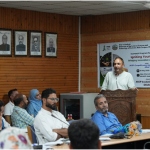The substitution of the IPC, CrPC, and IEA with the BNS, BNSS, and BSA signifies a transformative shift in India’s criminal jurisprudence
India stands at the threshold of a monumental metamorphosis in its criminal justice framework, poised to supersede its archaic criminal laws with an innovative legal corpus. The Indian Penal Code (IPC) of 1860, the Code of Criminal Procedure (CrPC) of 1973, and the Indian Evidence Act (IEA) of 1872, relics of a bygone era, are set to be supplanted by the Bharatiya Nyaya Sanhita (BNS), Bharatiya Nagarik Suraksha Sanhita (BNSS), and Bharatiya Sakshya Adhiniyam (BSA) respectively. These legislative enactments, effective from July 1, 2024, herald a new epoch in India’s legal landscape, promising modernization, procedural efficiency, and the integration of technological advancements to expedite justice.
Bharatiya Nyaya Sanhita (BNS) versus Indian Penal Code (IPC)
The Bharatiya Nyaya Sanhita heralds a paradigmatic shift from the antiquated IPC, incorporating several cardinal reforms to address contemporary societal exigencies and to ensure the efficacious dispensation of justice.
- Simplification and Modernization: The BNS endeavours to streamline the legal framework by abridging the number of sections from 511 in the IPC to 358 in the BNS. This reduction purges redundant provisions and accentuates clarity and comprehensiveness, facilitating a more intelligible legal corpus. The simplification is not merely quantitative but qualitative, fostering a more accessible and equitable legal environment.
- Community Service as Punishment: A salient innovation within the BNS is the introduction of community service as a punitive measure for select minor offences. This progressive approach aligns with global penal practices and underscores a rehabilitative paradigm over retributive justice. The emphasis on community service as a corrective measure aims to reintegrate offenders into society, mitigating the social stigma attached to incarceration and promoting restorative justice.
- Gender Neutrality: The BNS makes significant strides towards gender neutrality. Terms such as “he” have been rendered applicable to all genders, encompassing transgender individuals. This reform reflects an inclusive approach to justice, ensuring the equitable application of laws irrespective of gender. The inclusivity inherent in this provision underscores a commitment to gender equality, a cornerstone of contemporary legal reforms.
- Prioritization of Offences Against Women and Children: The BNS accords chronological precedence to offences against women and children, underscoring their paramount importance. This prioritization manifests a resolute commitment to addressing and mitigating crimes that disproportionately impact these vulnerable demographics. Notably, the definition of rape has been expanded to include non-consensual acts within marriage where the wife is above 18 years, aligning with recent Supreme Court adjudications. This redefinition signifies a paradigm shift in the recognition of marital rape, reflecting evolving societal norms and judicial sensibilities.
- Codification of New Offences: The BNS codifies several novel offences such as mob lynching, organized crime, and snatching. These inclusions address emergent criminal phenomena inadequately covered by the IPC. The penal provisions for mob lynching, equating it with murder, reflect a stringent response to a pernicious social menace. This codification of contemporary criminal activities ensures the legal framework remains pertinent and responsive to the dynamic nature of crime.
- Abrogation of Archaic Offences: Obsolete provisions, such as those pertaining to adultery and unnatural offences, have been expunged. This aligns with recent judicial pronouncements that invalidated these laws, thereby modernizing the legal framework to resonate with contemporary societal norms. The abrogation of such antiquated offences symbolizes a progressive shift towards a more enlightened and humane legal order.
Bharatiya Nagarik Suraksha Sanhita (BNSS) versus Code of Criminal Procedure (CrPC)
The Bharatiya Nagarik Suraksha Sanhita aims to overhaul the procedural dimensions of the CrPC, emphasizing efficiency and the integration of technology to expedite the criminal justice process.
- Enforced Timelines for Investigations and Trials: The BNSS mandates stringent timelines for various procedural stages, targeting the endemic issue of judicial delays. This reform seeks to ensure the prompt dispensation of justice, addressing one of the cardinal criticisms of the extant system. The imposition of these timelines is envisaged to alleviate the protracted nature of legal proceedings, thereby enhancing public confidence in the judiciary.
- Integration of Technological Advancements: The BNSS mandates the incorporation of technological tools in criminal investigations and proceedings. This encompasses electronic communication for the service of summons, digital submission of documents, and the employment of audio-visual means during investigations and trials. Such measures are anticipated to augment procedural efficiency and precision, mitigating human error and fostering transparency in legal processes.
- Statutory Recognition of Forensic Science: The BNSS grants statutory recognition to forensic science, mandating its utilization in criminal investigations. This reform aims to fortify the evidentiary base with scientific rigor, thereby diminishing reliance on potentially fallible oral testimonies. The statutory endorsement of forensic methodologies signifies a pivotal advancement towards empirical and objective adjudication.
Bharatiya Sakshya Adhiniyam (BSA) versus Indian Evidence Act (IEA)
The Bharatiya Sakshya Adhiniyam introduces substantial reforms to the law of evidence, particularly in the realm of electronic evidence, thereby supplanting the Indian Evidence Act.
- Admissibility of Electronic Evidence: The BSA expansively broadens the scope of admissible evidence to encompass digital and electronic formats. This reform is imperative in the contemporary digital milieu, where a substantial proportion of communication and transactions occur electronically. The BSA ensures the legal parity and enforceability of electronic evidence with traditional forms of evidence, thereby modernizing the evidentiary framework to align with technological advancements.
- Clarification on Certification and Admissibility: The BSA elucidates the requisites for the certification and admissibility of electronic evidence, resolving previous ambiguities and establishing a clearer framework for its inclusion in judicial proceedings. This clarity is essential for the seamless integration of digital evidence into the judicial process, ensuring its reliability and authenticity.
- Expanded Definitions of Evidence: The BSA extends the definitions of primary and secondary evidence to incorporate digital formats. This modernization ensures that the legal system remains consonant with technological advancements, thereby enhancing the prosecution’s capacity to effectively marshal evidence. The comprehensive definitions encompass a broad spectrum of digital artifacts, ensuring the holistic representation of electronic evidence.
- Key Reforms and Their Implications: The reforms encapsulated in the BNS, BNSS, and BSA are meticulously designed to engender a more efficient, inclusive, and technologically adept legal system.
- Addressing Contemporary Criminal Phenomena: The new statutes are meticulously crafted to address the evolving nature of crime, with specific provisions for novel offences such as organized crime and mob lynching. This renders the legal framework more pertinent and capable of confronting present-day challenges. The incorporation of these offences into the statutory framework signifies a proactive approach to criminal jurisprudence, ensuring its relevance and efficacy.
- Promoting Gender Parity: By rendering several offences gender-neutral and affording equal protection to all genders, the new laws promulgate gender parity. This shift signifies a substantial step towards a more just and equitable society. The legislative emphasis on gender neutrality reflects a commitment to universal justice, transcending traditional gender biases.
- Augmenting Procedural Efficiency: The imposition of stringent timelines and the integration of technology into legal processes are anticipated to substantially curtail judicial delays. This will not only expedite trials but also alleviate the burden on the judiciary. The technological integration promises a paradigm shift in legal procedures, fostering a more streamlined and efficient judicial process.
- Emphasis on Rehabilitation over Retribution: The inclusion of community service as a punitive measure underscores a shift towards rehabilitation rather than mere retribution. This approach is poised to reduce recidivism and facilitate the reintegration of offenders into society. The rehabilitative emphasis signifies a humane approach to justice, prioritizing the societal reintegration of offenders over punitive measures.
- Fortification of Evidence Law: By extending the scope of admissible evidence to include electronic formats, the BSA ensures that the justice system can effectively address crimes in the digital age. This reform strengthens the overall evidentiary framework and enhances the prosecution’s ability to substantiate cases. The fortification of evidence law through the inclusion of digital evidence underscores the judiciary’s adaptability to contemporary technological advancements.
Conclusion
The substitution of the IPC, CrPC, and IEA with the BNS, BNSS, and BSA signifies a transformative shift in India’s criminal jurisprudence. These reforms embody a commitment to modernization, efficiency, and inclusivity. By addressing contemporary issues, promoting gender parity, enhancing procedural efficiency, emphasizing rehabilitation, and fortifying evidence laws, these new statutes aim to create a more effective and just legal framework.
As India transitions to these new legal paradigms, it is imperative for all stakeholders, including judges, legal practitioners, and law enforcement officers, to familiarize themselves with the intricacies of these changes. This will ensure that the legal system can adeptly leverage these reforms to deliver justice in a manner that is timely, equitable, and attuned to the exigencies of a modern society. The promulgation of the BNS, BNSS, and BSA heralds a new epoch in India’s legal landscape, one that promises to be more responsive, resilient, and reflective of contemporary societal values.
Moreover, these reforms are expected to engender a more nuanced and empathetic approach to criminal justice, fostering a legal environment that not only deters crime but also addresses its root causes. The holistic nature of these reforms aims to foster a legal environment that not only deters crime but also addresses its root causes, thereby ensuring a just and equitable society. By focusing on rehabilitation, inclusivity, and technological advancements, the BNS, BNSS, and BSA collectively pave the way for a future where the criminal justice system is not only a mechanism of punishment but also a beacon of hope, reform, and societal progression. This transformation underscores India’s commitment to evolving its legal framework in alignment with global best practices and contemporary realities, ultimately striving towards a more humane and just society.
(Author is Advocate, Supreme Court of India. Feedback: [email protected])








